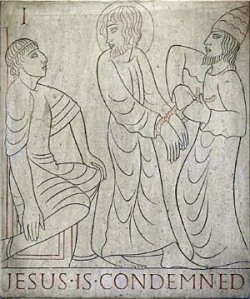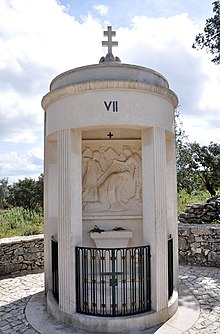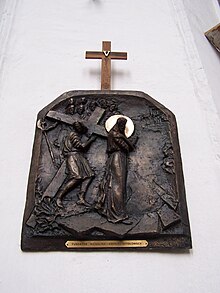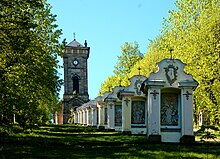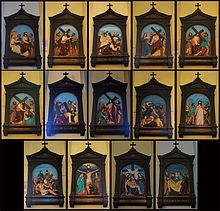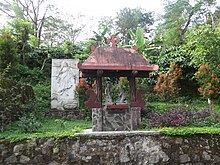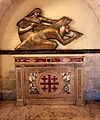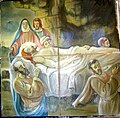“I have told you these things so that in Me you may have peace. In this world you will have trouble. But take heart! I have overcome the world.”
 |
| click to enlarge |

He gave the earth that bears, the air that lifts,
Water to cleanse and cool, fire to burn,
And from these elements he forged the iron,
From strands of life he wove the growing wood,
He made the stones that pave the roads of Zion
He saw it all and saw that it is good.
We took his iron to edge an axe’s blade,
We took the axe and laid it to the tree,
We made a cross of all that he has made,
And laid it on the one who made us free.
Now he receives again and lifts on high
The gifts he gave and we have turned awry.

III Jesus falls the first time
He made the stones that pave the roads of ZionAnd well he knows the path we make him tread
He met the devil as a roaring lion
And still refused to turn these stones to bread,
Choosing instead, as Love will always choose,
This darker path into the heart of pain.
And now he falls upon the stones that bruise
The flesh, that break and scrape the tender skin.
He and the earth he made were never closer,
Divinity and dust come face to face.
We flinch back from his via dolorosa,
He sets his face like flint and takes our place,
Staggers beneath the black weight of us all
And falls with us that he might break our fall.

IV Jesus meets His Mother
Was also hers whose love enfolded him
In flesh and wove him in her womb. Again
The sword is piercing. She, who cradled him
And gentled and protected her young son
Must stand and watch the cruelty that mars
Her maiden making. Waves of pain that stun
And sicken pass across his face and hers
As their eyes meet. Now she enfolds the world
He loves in prayer; the mothers of the disappeared
Who know her pain, all bodies bowed and curled
In desperation on this road of tears,
All the grief-stricken in their last despair,
Are folded in the mantle of her prayer.

V Simon of Cyrene carries the cross
In desperation on this road of tearsBystanders and bypassers turn away
In other’s pain we face our own worst fears
And turn our backs to keep those fears at bay
Unless we are compelled as this man was
By force of arms or force of circumstance
To face and feel and carry someone’s cross
In Love’s full glare and not his backward glance.
So Simon, no disciple, still fulfilled
The calling: ‘take the cross and follow me’.
By accident his life was stalled and stilled
Becoming all he was compelled to be.
Make me, like him, your pressed man and your priest,
Your alter Christus, burdened and released.

VI Veronica wipes the face of Jesus
Bystanders and bypassers turn awayAnd wipe his image from their memory
She keeps her station. She is here to stay
And stem the flow. She is the reliquary
Of his last look on her. The bloody sweat
And salt tears of his love are soaking through
The folds of her devotion and the wet
folds of her handkerchief, like the dew
Of morning, like a softening rain of grace.
Because she wiped the grime from off his skin,
And glimpsed the godhead in his human face
Whose hidden image we all bear within,
Through all our veils and shrouds of daily pain
The face of god is shining once again.

VII Jesus falls the second time
Through all our veils and shrouds of daily pain,Through our bruised bruises and re-opened scars,
He falls and stumbles with us, hurt again
When we are hurt again. With us he bears
The cruel repetitions of our cruelty;
The beatings of already beaten men,
The second rounds of torture, the futility
Of all unheeded pleading, every scream in vain.
And by this fall he finds the fallen souls
Who passed a first, but failed a second trial,
The souls who thought their faith would hold them whole
And found it only held them for a while.
Be with us when the road is twice as long
As we can bear. By weakness make us strong.

But still he holds the road and looks in love
On all of us who look on him. Our pain
As close to him as his. These women move
Compassion in him as he does in them.
He asks us both to weep and not to weep.
Women of Gaza and Jerusalem,
Women of every nation where the deep
Wounds of memory divide the land
And lives of all your children, where the mines
Of all our wars are sown: Afghanistan ,
Iraq, the Cote d’Ivoire… he reads the signs
And weeps with you and with you he will stay
Until the day he wipes your tears away.

When all your staying power has run out
You can’t go on, you go on anyway.
He stumbles just beside you when the doubt
That always haunts you, cuts you down at last
And takes away the hope that drove you on.
This is the third fall and it hurts the worst
This long descent through darkness to depression
From which there seems no rising and no will
To rise, or breathe or bear your own heart beat.
Twice you survived; this third will surely kill,
And you could almost wish for that defeat
Except that in the cold hell where you freeze
You find your God beside you on his knees.\
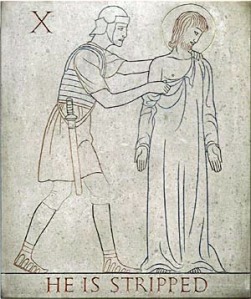
He goes with you, his cradle to your grave.
Now is the time to loosen, cast away
The useless weight of everything but love
For he began his letting go before,
Before the worlds for which he dies were made,
Emptied himself, became one of the poor,
To make you rich in him and unafraid.
See as they strip the robe from off his back
They strip away your own defences too
Now you could lose it all and never lack
Now you can see what naked Love can do
Let go these bonds beneath whose weight you bow
His stripping strips you both for action now

And spread his arms and nail them to the cross,
The dark nails pierce him and the sky turns black,
And love is firmly fastened onto loss.
But here a pure change happens. On this tree
Loss becomes gain, death opens into birth.
Here wounding heals and fastening makes free
Earth breathes in heaven, heaven roots in earth.
And here we see the length, the breadth, the height
Where love and hatred meet and love stays true
Where sin meets grace and darkness turns to light
We see what love can bear and be and do,
And here our saviour calls us to his side
His love is free, his arms are open wide.
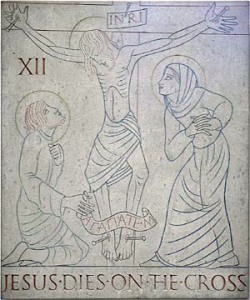
We watch him as he labours to draw breath
He takes our breath away to give it back,
Return it to it’s birth through his slow death.
We hear him struggle breathing through the pain
Who once breathed out his spirit on the deep,
Who formed us when he mixed the dust with rain
And drew us into consciousness from sleep.
His spirit and his life he breathes in all
Mantles his world in his one atmosphere
And now he comes to breathe beneath the pall
Of our pollutions, draw our injured air
To cleanse it and renew. His final breath
Breathes us, and bears us through the gates of death.

Now on this cross his body breathes no more
Here at the centre everything is still
Spent, and emptied, opened to the core.
A quiet taking down, a prising loose
A cross-beam lowered like a weighing scale
Unmaking of each thing that had its use
A long withdrawing of each bloodied nail,
This is ground zero, emptiness and space
With nothing left to say or think or do
But look unflinching on the sacred face
That cannot move or change or look at you.
Yet in that prising loose and letting be
He has unfastened you and set you free.
Before the stir and movement of our grief
Which bears it’s pain with rhythm, ritual,
Beautiful useless gestures of relief.
So they anoint the skin that cannot feel
Soothing his ruined flesh with tender care,
Kissing the wounds they know they cannot heal,
With incense scenting only empty air.
He blesses every love that weeps and grieves
And makes our grief the pangs of a new birth.
The love that’s poured in silence at old graves
Renewing flowers, tending the bare earth,
Is never lost. In him all love is found
And sown with him, a seed in the rich ground.
Journey the Stations of the Cross in a profoundly beautiful way this Lent in art and poetry. The paintings are bold, brilliant, prayerful depictions of the Passion of Christ, and the poetry is a mystical love song to Our Lord. Wherever you are, enter into a sacred time with the Lord through original artwork and poems for the fourteen Stations with readings by the author, Caitlyn Pszonka, set to a reflective musical score.
Stations of the Cross
The style, form, and placement of the stations vary widely. The typical stations are small plaques with reliefs or paintings placed around a church nave. Modern minimalist stations can be simple crosses with abl numeral in the centre.[4][5] Occasionally the faithful might say the stations of the cross without there being any image, such as when the pope leads the stations of the cross around the Colosseum in Rome on Good Friday.[6]The Stations of the Cross or the Way of the Cross, also known as the Way of Sorrows or the Via Crucis, refers to a series of images depicting Jesus Christ on the day of his crucifixion an[1] As a physical devotion involving standing, kneeling and genuflections, the Stations of the Cross are tied with the Christian themes of repentance and mortification of the flesh.[2][3]
History
The Stations of the Cross originated in pilgrimage to Jerusalem and a desire to reproduce the Via Dolorosa. Imitating holy places was not a new concept. For example, the religious complex of Santo Stefano in Bologna, Italy, replicated the Church of the Holy Sepulchre and other religious sites, including Mount of Olives and Valley of Josaphat.[7]
After the siege of 1187, Jerusalem fell to the forces of Saladin, the first sultan of Egypt and Syria. Forty years later Franciscans were allowed back into the Holy Land. Their founder, Saint Francis of Assisi, held the Passion of Christ in special veneration and is said to have been the first person to receive stigmata.[8] In 1217, St. Francis also founded the Custody of the Holy Land to guard and promote the devotion to holy places. Their efforts were recognized when Franciscans were officially proclaimed custodians of holy places by Pope Clement VI in 1342.[8] Although several travelers who visited the Holy Land during the 12–14th centuries (e.g. Riccoldo da Monte di Croce, Burchard of Mount Sion, James of Verona), mention a "Via Sacra", i.e. a settled route that pilgrims followed, there is nothing in their accounts to identify this with the Way of the Cross, as we understand it.[9] The earliest use of the word "stations", as applied to the accustomed halting-places in the Via Sacra at Jerusalem, occurs in the narrative of an English pilgrim, William Wey, who visited the Holy Land in the mid-15th century, and described pilgrims following the footsteps of Christ to Golgotha. In 1521, a book called Geystlich Strass (German: "spiritual road") was printed with illustrations of the stations in the Holy Land.[9]
During the 15th and 16th centuries the Franciscans began to build a series of outdoor shrines in Europe to duplicate their counterparts in the Holy Land. The number of stations varied between seven and thirty; seven was common. These were usually placed, often in small buildings, along the approach to a church, as in a set of 1490 by Adam Kraft, leading to the Johanniskirche in Nuremberg.[10] A number of rural examples were established as attractions in their own right, usually on attractive wooded hills. These include the Sacro Monte di Domodossola (1657) and Sacro Monte di Belmonte (1712), and form part of the Sacri Monti of Piedmont and Lombardy World Heritage Site, together with other examples on different devotional themes. In these the sculptures are often approaching life-size and very elaborate. Remnants of these are often referred to as calvary hills.
In 1686, in answer to their petition, Pope Innocent XI granted to the Franciscans the right to erect stations within their churches. In 1731, Pope Clement XII extended to all churches the right to have the stations, provided that a Franciscan father erected them, with the consent of the local bishop. At the same time the number was fixed at fourteen. In 1857, the bishops of England were allowed to erect the stations by themselves, without the intervention of a Franciscan priest, and in 1862 this right was extended to bishops throughout the church.[11]
Stations
The early set of seven scenes was usually numbers 2, 3, 4, 6, 7, 11 and 14 from the list below.[10] The standard set from the late 16th to 20th centuries has consisted of 14 pictures or sculptures depicting the following scenes:[12][13][14]
- Jesus is condemned to death
- Jesus takes up his Cross
- Jesus falls for the first time
- Jesus meets his Mother
- Simon of Cyrene helps Jesus carry the Cross
- Veronica wipes the face of Jesus
- Jesus falls for the second time
- Jesus meets the women of Jerusalem
- Jesus falls for the third time
- Jesus is stripped of his garments (sometimes called the "Division of Robes")
- Jesus is nailed to the Cross
- Jesus dies on the Cross
- Jesus is taken down from the Cross
- Jesus is laid in the tomb
Although not traditionally part of the Stations, the Resurrection of Jesus is sometimes included as an unofficial fifteenth station.[dubious ][15] One very different version, called the Via Lucis ("Way of Light"), comprising the Fourteen Stations of Light or Stations of the Resurrection, starts Jesus rising from the dead and ends with Pentecost.[16]
Scriptural form
Out of the fourteen traditional Stations of the Cross, only eight have a clear scriptural foundation. Station 4 appears out of order from scripture; Jesus's mother is present at the crucifixion but is only mentioned after Jesus is nailed to the cross and before he dies (between stations 11 and 12). The scriptures contain no accounts whatsoever of any woman wiping Jesus's face nor of Jesus falling as stated in Stations 3, 6, 7 and 9. Station 13 (Jesus's body being taken down off the cross and laid in the arms of his mother Mary) differs from the gospels' record, which states that Joseph of Arimathea took Jesus down from the cross and buried him.
To provide a version of this devotion more closely aligned with the biblical accounts, Pope John Paul II introduced a new form of devotion, called the Scriptural Way of the Cross, on Good Friday 1991. He celebrated that form many times but not exclusively at the Colosseum in Italy,[17][18] using the following sequence (as published by the United States Catholic Conference of Bishops):[19]
- Jesus is in the Garden of Gethsemane;
- Jesus is betrayed by Judas and arrested;
- Jesus is condemned by the Sanhedrin;
- Jesus is denied by Peter;
- Jesus is judged by Pilate;
- Jesus is scourged and crowned with thorns;
- Jesus takes up his cross;
- Jesus is helped by Simon of Cyrene to carry his cross;
- Jesus meets the women of Jerusalem;
- Jesus is crucified;
- Jesus promises his kingdom to the repentant thief;
- Jesus entrusts Mary and John to each other;
- Jesus dies on the cross; and
- Jesus is laid in the tomb.
In 2007, Pope Benedict XVI approved this set of stations for meditation and public celebration.[20][21]
The New Way of the Cross (Philippines)[edit]
Another set of Stations are being used by the Catholic Church in the Philippines. Filipinos use this set during Visita Iglesia, which is usually done every Holy Week.
- The Last Supper
- The Agony in Gethsemane
- Jesus Before the Sanhedrin
- Jesus is scourged and crowned with thorns
- Jesus Receives His Cross
- Jesus Falls under the weight of the Cross
- Simon of Cyrene Helps Jesus carry the Cross
- Jesus meets the women of Jerusalem
- Jesus is nailed to the Cross
- The Repentant Thief
- Mary and John at the Foot of the Cross
- Jesus dies on the Cross
- Jesus is laid in His Tomb
- Jesus rises from the Dead
Modern usage
In the Roman Catholic Church, the devotion may be conducted personally by the faithful, making their way from one station to another and saying the prayers, or by having an officiating celebrant move from cross to cross while the faithful make the responses. The stations themselves must consist of, at the very least, fourteen wooden crosses—pictures alone do not suffice—and they must be blessed by someone with the authority to erect stations.[22]
Pope John Paul II led an annual public prayer of the Stations of the Cross at the Roman Colosseum on Good Friday. Originally, the pope himself carried the cross from station to station, but in his last years when age and infirmity limited his strength, John Paul presided over the celebration from a stage on the Palatine Hill, while others carried the cross. Just days prior to his death in 2005, Pope John Paul II observed the Stations of the Cross from his private chapel. Each year a different person is invited to write the meditation texts for the Stations. Past composers of the Papal Stations include several non-Catholics. The pope himself wrote the texts for the Great Jubilee in 2000 and used the traditional Stations.
The celebration of the Stations of the Cross is especially common on the Fridays of Lent, especially Good Friday. Community celebrations are usually accompanied by various songs and prayers. Particularly common as musical accompaniment is the Stabat Mater. At the end of each station the Adoramus Te is sometimes sung. The Alleluia is also sung, except during Lent.
Structurally, Mel Gibson's 2004 film, The Passion of the Christ, follows the Stations of the Cross.[23] The fifteenth and last station, the Resurrection, is not prominently depicted (compared to the other fourteen) but it is implied since the last shot before credit titles is Jesus resurrected and about to leave the tomb.
Debates
Place of Christ's resurrection
Some modern liturgists[24] say the traditional Stations of the Cross are incomplete without a final scene depicting the empty tomb and the resurrection of Jesus because Jesus' rising from the dead was an integral part of his salvific work on Earth. Advocates of the traditional form of the Stations ending with the body of Jesus being placed in the tomb say the Stations are intended as a meditation on the atoning death of Jesus, and not as a complete picture of his life, death, and resurrection. Another point of contention, at least between some ranking liturgists and traditionalists, is (the use of) the "New Way of the Cross" being recited exclusively in the Philippines and by Filipinos abroad.
The Stations of the Resurrection (also known by the Latin name of Via Lucis, Way of Light) are used in some churches at Eastertide to meditate on the Resurrection and Ascension of Jesus Christ.
Music
Franz Liszt wrote a Via Crucis for choir, soloists and piano or organ or harmonium in 1879. In 1931, French organist Marcel Dupré improvised and transcribed musical meditations based on fourteen poems by Paul Claudel, one for each station. Peter Maxwell Davies's Vesalii Icones (1969), for male dancer, solo cello and instrumental ensemble, brings together the Stations of the Cross and a series of drawings from the anatomical treatise De humani corporis fabrica (1543) by the Belgian physician Andreas van Wesel (Vesalius). In Davies's sequence, the final "station" represents the Resurrection, but of Antichrist, the composer's moral point being the need to distinguish what is false from what is real.[25] David Bowie regarded his 1976 song "Station to Station" as "very much concerned with the stations of the cross".[26] Paweł Łukaszewski wrote Via Crucis in 2000 and it was premiered by the Wrocław Opera on Good Friday March 30, 2018, and transmitted on TVP Kultura. Stefano Vagnini's 2002 modular oratorio, Via Crucis,[27] is a composition for organ, computer, choir, string orchestra and brass quartet.
As the Stations of the Cross are prayed during the season of Lent in Catholic churches, each station is traditionally followed by a verse of the Stabat Mater, composed in the 13th century by Franciscan Jacopone da Todi. James Matthew Wilson's poetic sequence, The Stations of the Cross, is written in the same meter as da Todi's poem.[28]
Literature
Dimitris Lyacos' third part of the Poena Damni trilogy, The First Death, is divided in fourteen sections in order to emphasise the "Via Dolorosa" of its marooned protagonist during his ascent on the mount of the island which constitutes the setting of the work.[citation needed][relevance questioned]
Gallery
See also
- Acts of Reparation to Jesus Christ
- Life of Jesus in the New Testament
- Seven Sorrows of Mary
- Sayings of Jesus on the cross
- Three Hours' Agony
- Via Lucis
References
- ^ "The Way of the Cross". Browne and Nolan.
- ^ Byrne, William (16 October 2020). 5 Things with Father Bill: Hope, Humor, and Help for the Soul. Loyola Press. ISBN 978-0-8294-5327-0.
- ^ Ryder, Henry Ignatius Dudley (1920). Sermons and Notes of Sermons. Sands & Company. p. 58.
- ^ "Stations of the Cross". St. Michael's Episcopal Church. 2012. Archived from the original on 17 February 2015. Retrieved 3 March 2015.
- ^ Chryssides, George D.; Wilkins, Margaret Z. (11 September 2014). Christians in the Twenty-First Century. Taylor & Francis. p. 51. ISBN 978-1-317-54557-6.
- ^ "Frommer's Events – Event Guide: Good Friday Procession in Rome (Palatine Hill, Italy)". Frommer's. Archived from the original on 7 January 2009. Retrieved 8 April 2008.
- ^ Ousterhout, Robert G. (1981). "The Church of Santo Stefano: A "Jerusalem" in Bologna". Gesta. 2 (20): 311–321. doi:10.2307/766940. ISSN 0016-920X. JSTOR 766940. S2CID 191752841.
- ^ a b Weitzel Gibbons, Mary (1995). Giambologna: Narrator of the Catholic Reformation. University of California Press. pp. 72–73. ISBN 978-0-520-08213-7.
- ^ a b Thurston, Herbert (1914). The Stations of the Cross: an account of their history and devotional purpose. London: Burns & Oates. pp. 20–21, 46. OCLC 843213.
- ^ a b Schiller, Gertrud, Iconography of Christian Art, Vol. II, p. 82, 1972 (English trans from German), Lund Humphries, London, ISBN 0-85331-324-5
- ^ The Catholic Encyclopedia (1907). s.v. "The Way of the Cross".
- ^ "Text of the Stations of the Cross for 2020, led by Pope Francis". Aleteia / Foundation for Evangelization through the Media (FEM). 9 April 2020. Retrieved 19 May 2020.
- ^ "First Station: Jesus is condemned to death". Libreria Editrice Vaticana. Retrieved 19 May 2020.
- ^ Francesca Merlo (10 April 2020). "Way of the Cross: Meditations from a corrections facility". Vatican News. Retrieved 19 May 2020.
- ^ "Fr. William Saunders". Archived from the original on 2009-04-30. Retrieved 2009-04-04.
Because of the intrinsic relationship between the passion and death of our Lord with His resurrection, several of the devotional booklets now include a 15th station, which commemorates the Resurrection.
- ^ "The Official Web Site for the Archdiocese of Detroit" (PDF). Archived from the original (PDF) on 2010-12-23. Retrieved 2012-02-13.
In some contemporary Stations of the Cross, a fifteenth station has been added to commemorate the Resurrection of the Lord.
- ^ Joseph M Champlin, The Stations of the Cross With Pope John Paul II Liguori Publications, 1994, ISBN 0-89243-679-4
- ^ Pope John Paul II, Meditation and Prayers for the Stations of the Cross at the Colosseum Archived 2013-06-03 at the Wayback Machine, Good Friday, 2000
- ^ "Scriptural Stations of the Cross". www.usccb.org. Retrieved 2019-03-11.
- ^ Office for the Liturgical Celebrations of the Supreme Pontiff (April 6, 2007). "Way of the Cross at the Colosseum". Vatican.va. Archived from the original on July 7, 2013. Retrieved February 18, 2018.
- ^ "Pope Benedict leads Good Friday service". April 6, 2007 – via www.abc.net.au.
- ^ "Catholic Encyclopedia: Way of the Cross". Newadvent.org. 1912-10-01. Retrieved 2014-07-03.
- ^ Review Archived 2012-04-30 at the Wayback Machine, United States Conference of Catholic Bishops, 2004
- ^ McBrien, Richard P.; Harold W. Attridge (1995). The HarperCollins encyclopedia of Catholicism. p. 1222. ISBN 978-0-06-065338-5.
- ^ Composer's note in the published score (Boosey and Hawkes, B & H 20286).
- ^ Cavanagh, David (February 1997). "ChangesFiftyBowie". Q magazine: 52–59.
- ^ Falcon Valley Music Ed., Stefano Vagnini, Via Crucis, Rome, 2002.[not specific enough to verify]
- ^ "The Stations of the Cross : Clarion Review". www.clarionreview.org. Retrieved 2017-12-16.
External links
| Wikimedia Commons has media related to Stations of the Cross. |
- Scriptural Stations of the Cross from the United States Conference of Catholic Bishops
- The Way Of The Cross: Presentation (historical development; present form, both traditional and scriptural), from the official Vatican website (accessed 19 May 2020)
- Via Crucis celebration texts used by the Vatican on Good Fridays since 1991 from the official Vatican website
- Video: Corine Schleif. Adam Kraft's Seven Falls of Christ. Walking the History of Emotions in Nuremberg. Part 1
- Video: Corine Schleif. Adam Kraft's Seven Falls of Christ. Walking the History of Emotions in Nuremberg. Part 2
- "Way of the Cross" article from The Catholic Encyclopedia



